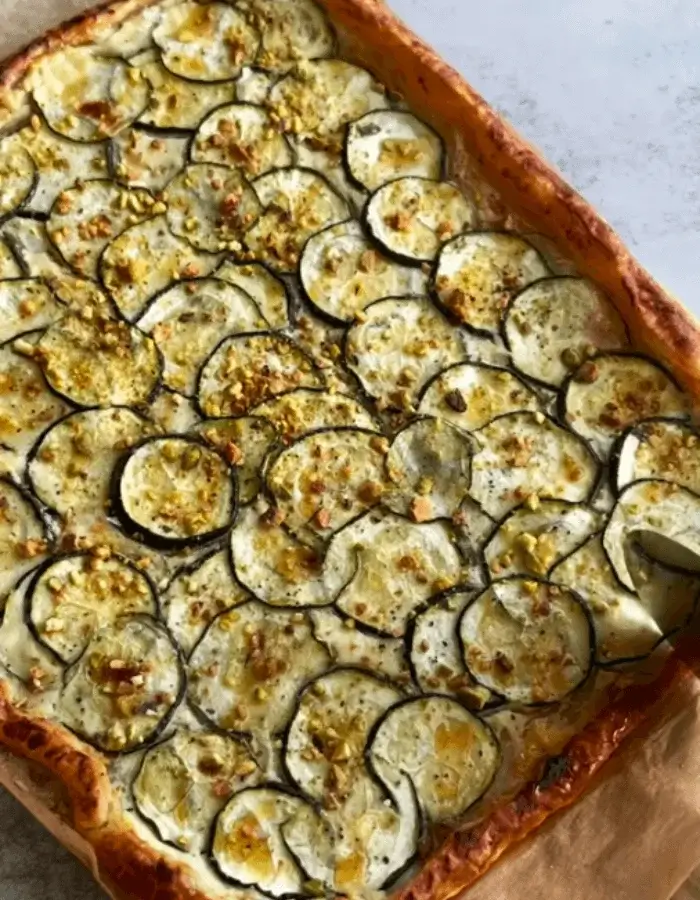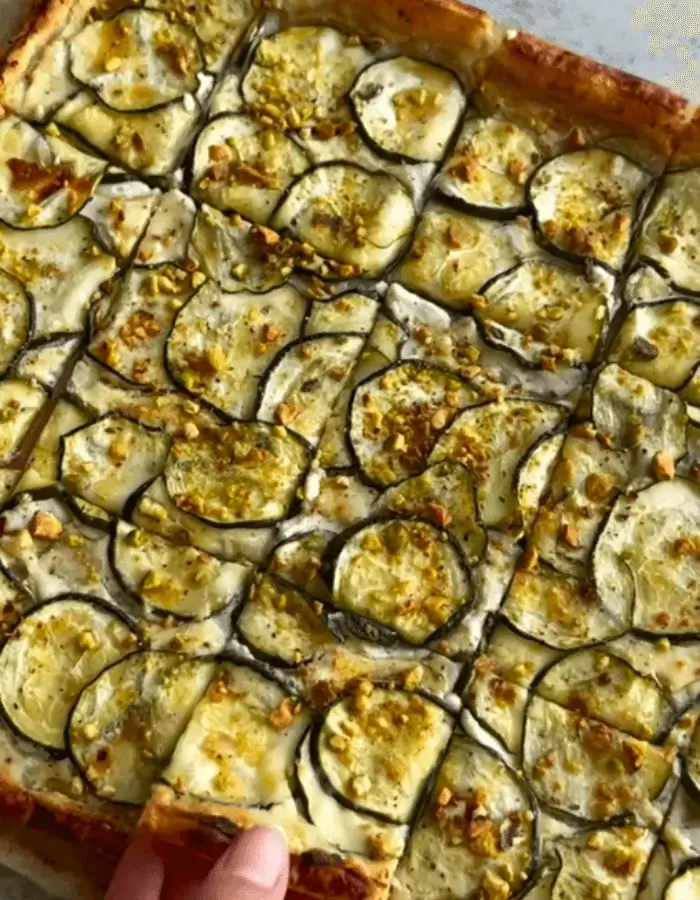Zucchini Ricotta Pastry
We may earn a commission from recommended products, at no extra cost to you. See Disclosure.
- Food processor
- Chef's knife
INGREDIENTS
- 1 sheet puff pastry, thawed
- 1 egg, beaten
- 1 medium zucchini, thinly sliced
- 1 tablespoon olive oil, plus more as needed
- ½ teaspoon salt
- ¼ teaspoon ground black pepper
- ½ cup ricotta cheese
- ½ cup feta cheese, crumbled
- 1 teaspoon honey, plus more for drizzling
- 1 teaspoon lemon zest
- 1 tablespoon pistachios, crushed
- Flakey sea salt, for finishing
- Hot honey, for drizzling
INSTRUCTIONS
- Preheat the oven to 375°F (190°C). Line a sheet pan with parchment paper.
- In a food processor or blender, combine the ricotta, feta, olive oil, honey, and lemon zest. Blend until smooth, light, and creamy. Season with salt and pepper to taste.
- On a lightly floured surface, roll out the puff pastry slightly to even the edges, if needed. Transfer to the prepared sheet pan. Spread the whipped ricotta over the center of the pastry, leaving a 1-inch/2.5 cm border around the edges.
- In a bowl, toss the zucchini slices with a drizzle of olive oil, salt, and pepper until evenly coated. Layer them over the ricotta mixture in slightly overlapping rows. Brush the exposed pastry edges with the beaten egg.
- Bake for 25 to 30 minutes, or until the pastry is deeply golden and puffed.
- Remove from the oven. While still warm, drizzle with hot honey, sprinkle with crushed pistachios, and finish with flakey salt.
- Serve warm or at room temperature, cut into squares.

FAQ
Can I make this ricotta pastry ahead of time?
This ricotta pastry can be made ahead of time with a few storage tips in mind. If you’re preparing it for a gathering, it’s best to bake it the same day, as puff pastry tends to lose its crispness when refrigerated. You can, however, prepare all the components in advance. Whip the ricotta and feta mixture and store it in an airtight container in the refrigerator for up to two days. The zucchini can be sliced ahead and stored separately, but don’t toss it with oil or season it until you’re ready to assemble. Assemble the ricotta pastry just before baking to prevent the pastry from getting soggy.

What other vegetables work well in a ricotta pastry?
Thinly sliced cherry tomatoes, roasted red peppers, sautéed mushrooms, or caramelized onions all make excellent toppings. Blanched asparagus or roasted butternut squash can also be added for a seasonal twist. The key is to avoid vegetables that release too much moisture, which can make the puff pastry soggy. Pre-cooking vegetables like mushrooms or spinach ensures they’re dry and flavorful before layering them onto the ricotta. Always let cooked vegetables cool completely before assembling to avoid melting the ricotta and softening the pastry. The base ricotta mixture also pairs beautifully with herbs like basil, thyme, or chives.
How to keep the puff pastry from getting soggy under the ricotta
First, make sure the ricotta and feta mixture is thick and well-whipped. If your ricotta seems watery, drain it using a fine-mesh sieve or cheesecloth for 15–30 minutes before blending. When it comes to vegetables, avoid layering them onto the pastry raw if they tend to release water—zucchini, for instance, should be salted and patted dry, or lightly pre-roasted. Also, spreading a thin layer of the cheese mixture and not overloading the tart helps the pastry bake through and puff up properly. Baking at the correct temperature—375°F (190°C)—and not overcrowding the sheet pan will help the ricotta pastry develop a crisp, golden base.
Can I freeze this pastry after baking?
You can freeze the baked pastry, though the texture of the puff pastry may be slightly less crisp after reheating. To freeze, allow the pastry to cool completely, then wrap it tightly in plastic wrap and foil or place it in a freezer-safe airtight container. It can be frozen for up to one month. To reheat, place the frozen ricotta pastry on a baking sheet and warm in a 350°F (175°C) oven for about 15 to 20 minutes, or until hot and crispy. Avoid reheating in the microwave, as this will make the puff pastry soft and chewy.

Can I make this ricotta pastry without a food processor?
You can easily make this pastry without a food processor. Use a mixing bowl and a sturdy whisk or spatula to combine the ricotta, crumbled feta, olive oil, honey, and lemon zest. Beat the mixture vigorously until smooth and fluffy. If the feta is very firm, crumble it finely or mash it with a fork before mixing. A handheld electric mixer also works well to create a light texture. While a food processor provides a slightly smoother result, especially for larger batches, manually whipping the cheese mixture still yields a deliciously creamy filling.
What type of puff pastry is best for this recipe?
It’s best to use all-butter puff pastry if available, as it yields the most flavorful and crisp result. All-butter varieties puff up beautifully and provide a rich, golden base that complements the creamy ricotta and savory toppings. Many grocery store brands offer puff pastry made with vegetable shortening, which will still work but may lack the depth of flavor and may brown less evenly.
Can I make a sweet version of this pastry?
You can absolutely make a sweet version of ricotta pastry by adjusting the filling and toppings. Start with the same puff pastry base, and prepare a whipped ricotta mixture using ricotta cheese, a small amount of powdered sugar, vanilla extract, and lemon zest. Optionally, add a spoonful of honey or orange blossom water for extra flavor. Spread this sweetened ricotta mixture over the pastry and top with fruit such as sliced figs, strawberries, blueberries, or poached pears. After baking, finish with a drizzle of honey or maple syrup and a dusting of powdered sugar or crushed nuts.

